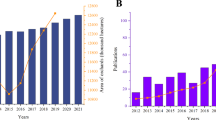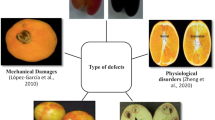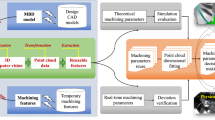Abstract
The 3D printing process has advantages in the processing of complex parts, and its application is more and more extensive. However, the 3D printing process is still immature compared to traditional machining, it is more prone to produce defect products. Detecting defects on the surface of 3D printed parts is very important to ensure product quality. However, existing methods are barely capable to detect small 3D printing defects, as small defects are partially submerged by noise. In order to solve the problem, we proposed a novel method based on 3D machine vision to detect small 3D printing defects in this paper. The proposed method can be divided into two steps, potential defect regions extraction and accurate defect detection. Specifically, in the first stage, MBH (moving least squares smoothing and rough boundary removal-based Harris keypoint) and INRoPS (Improved Normal Rotated Projection Statistics) feature descriptor is proposed to extract the potential defect region, which has the advantages of robustness and high computational efficiency. In the second stage, a defect detection method based on neighborhood point calculation is proposed, which can accurately extract the complete shape of the defect. Experiments prove that the proposed method is more accurate and robust than other methods for both potential defect region extraction and precise defect detection.









Similar content being viewed by others
Data availability
Data will be available from corresponding author upon reasonable request.
References
Gui X, Liu X, Tian Q, Guo W (2018) Multimodal data fusion in 3-D printing quality prediction. IEEE Sens Lett 3:1–4
Bowoto OK, Oladapo BI, Zahedi SA, Omigbodun FT, Emenuvwe OP (2020) Analytical modelling of in situ layer-wise defect detection in 3D-printed parts: additive manufacturing. Int J Adv Manuf Technol 111:2311–2321. https://doi.org/10.1007/s00170-020-06241-6
Farhan Khan M, Alam A, Ateeb Siddiqui M, Saad Alam M, Rafat Y, Salik N, Al-Saidan I (2021) Real-time defect detection in 3D printing using machine learning. Mater Today Proc 42:521–528. https://doi.org/10.1016/j.matpr.2020.10.482
Lu QY, Wong CH (2018) Additive manufacturing process monitoring and control by non-destructive testing techniques: challenges and in-process monitoring. Virtual Phys Prototyp 13:39–48. https://doi.org/10.1080/17452759.2017.1351201
Kanko JA, Sibley AP, Fraser JM (2016) In situ morphology-based defect detection of selective laser melting through inline coherent imaging. J Mater Process Technol 231:488–500. https://doi.org/10.1016/j.jmatprotec.2015.12.024
Grasso M, Demir AG, Previtali B, Colosimo BM (2018) In situ monitoring of selective laser melting of zinc powder via infrared imaging of the process plume. Robot Comput-Integr Manuf 49:229–239. https://doi.org/10.1016/j.rcim.2017.07.001
Bartlett JL, Heim FM, Murty YV, Li X (2018) In situ defect detection in selective laser melting via full-field infrared thermography. Addit Manuf 24:595–605. https://doi.org/10.1016/j.addma.2018.10.045
Thompson A, Maskery I, Leach RK (2016) X-ray computed tomography for additive manufacturing: a review. Meas Sci Technol 27:072001. https://doi.org/10.1088/0957-0233/27/7/072001
Cunningham R, Nicolas A, Madsen J, Fodran E, Anagnostou E, Sangid MD, Rollett AD (2017) Analyzing the effects of powder and post-processing on porosity and properties of electron beam melted Ti-6Al-4V. Mater Res Lett 5:516–525. https://doi.org/10.1080/21663831.2017.1340911
Strantza M, Aggelis DG, De Baere D, Guillaume P, Van Hemelrijck D (2015) Evaluation of SHM system produced by additive manufacturing via acoustic emission and other NDT methods. Sensors 15:26709–26725. https://doi.org/10.3390/s151026709
Everton S, Dickens P, Tuck C, Dutton B (2018) Using laser ultrasound to detect subsurface defects in metal laser powder bed fusion components. JOM 70:378–383. https://doi.org/10.1007/s11837-017-2661-7
Cummings I, Hillstrom E, Newton R, Flynn E, Wachtor A (2016) In-process ultrasonic inspection of additive manufactured parts. In: Mains M (ed) Topics in Modal Analysis & Testing, vol 10. Springer International Publishing, Cham, pp 235–247
Liang D, Geng Q, Wei Z, Vorontsov DA, Kim EL, Wei M, Zhou H (2021) Anchor retouching via model interaction for robust object detection in aerial images. IEEE Trans Geosci Remote Sens 60:1–13
Liang D, Kang B, Liu X, Gao P, Tan X, Kaneko S (2021) Cross-scene foreground segmentation with supervised and unsupervised model communication. Pattern Recognit 117:107995
Xiang S, Liang D, Kaneko S, Asano H (2020) Robust defect detection in 2D images printed on 3D micro-textured surfaces by multiple paired pixel consistency in orientation codes. IET Image Process 14:3373–3384
Fang T, Jafari MA, Danforth SC, Safari A (2003) Signature analysis and defect detection in layered manufacturing of ceramic sensors and actuators. Mach Vis Appl 15:63–75. https://doi.org/10.1007/s00138-002-0074-1
Wu M, Phoha VV, Moon YB, Belman AK (2016) Detecting malicious defects in 3D printing process using machine learning and image classification. In: ASME International Mechanical Engineering Congress and Exposition. American Society of Mechanical Engineers, Phoenix, Arizona, p V014T07A004. https://doi.org/10.1115/IMECE2016-67641
Caggiano A, Zhang J, Alfieri V, Caiazzo F, Gao R, Teti R (2019) Machine learning-based image processing for on-line defect recognition in additive manufacturing. CIRP Ann 68:451–454. https://doi.org/10.1016/j.cirp.2019.03.021
Zhao X, Lian Q, He Z, Zhang S (2019) Region-based online flaw detection of 3D printing via fringe projection. Meas Sci Technol 31:035011. https://doi.org/10.1088/1361-6501/ab524b
Straub J (2015) Initial Work on the characterization of additive manufacturing (3D Printing) Using software image analysis. Mach 3:55–71. https://doi.org/10.3390/machines3020055
Zhang B, Ziegert J, Farahi F, Davies A (2016) In situ surface topography of laser powder bed fusion using fringe projection. Addit Manuf 12:100–107. https://doi.org/10.1016/j.addma.2016.08.001
Grasso M, Laguzza V, Semeraro Q, Colosimo BM (2017) In-Process monitoring of selective laser melting: spatial detection of defects via image data analysis. J Manuf Sci Eng 139:051001. https://doi.org/10.1115/1.4034715
Liu R, Wang Z, Sparks T, Liou F, Nedic C (2017) Stereo vision-based repair of metallic components. Rapid Prototyp J 23:65–73. https://doi.org/10.1108/RPJ-09-2015-0118
Grasso M, Colosimo BM (2017) Process defects and in situ monitoring methods in metal powder bed fusion: a review. Meas Sci Technol 28:044005. https://doi.org/10.1088/1361-6501/aa5c4f
Guo Y, Sohel F, Bennamoun M, Lu M, Wan J (2013) Rotational projection statistics for 3D local surface description and object recognition. Int J Comput Vis 105:63–86. https://doi.org/10.1007/s11263-013-0627-y
Fischler MA, Bolles RC (1981) Random sample consensus: a paradigm for model fitting with applications to image analysis and automated cartography. Commun ACM 24:381–395
Xue S, Zhang Z, Meng X, Lv Q, Tu X (2019) Point cloud registration method for pipeline workpieces based on RANSAC and improved ICP algorithms. IOP Conf Ser Mater Sci Eng 612:032190. https://doi.org/10.1088/1757-899X/612/3/032190
Pomerleau F, Colas F, Siegwart R (2015) A Review of point cloud registration algorithms for mobile robotics. Found Trends Robot 4:1–104. https://doi.org/10.1561/2300000035
Mineo C, Pierce SG, Summan R (2019) Novel algorithms for 3D surface point cloud boundary detection and edge reconstruction. J Comput Des Eng 6:81–91. https://doi.org/10.1016/j.jcde.2018.02.001
Bentley JL (1975) Multidimensional binary search trees used for associative searching. Commun ACM 18:509–517. https://doi.org/10.1145/361002.361007
Rusu RB, Blodow N, Beetz M (2009) Fast Point Feature Histograms (FPFH) for 3D registration. In: 2009 IEEE International Conference on Robotics and Automation. IEEE, Kobe, pp 3212–3217. https://doi.org/10.1109/ROBOT.2009.5152473
Johnson A (1997) A representation for 3D surface matching. PhD thesis, Robotics Institute, Carnegie Mellon University
Hutchison D, Kanade T, Kittler J, Kleinberg JM, Mattern F, Mitchell JC, Naor M, Nierstrasz O, Pandu Rangan C, Steffen B, Sudan M, Terzopoulos D, Tygar D, Vardi MY, Weikum G, Tombari F, Salti S, Di Stefano L (2010) Unique signatures of histograms for local surface description. In: Daniilidis K, Maragos P, Paragios N (eds) Computer Vision – ECCV 2010. Springer, Berlin Heidelberg, Berlin, Heidelberg, pp 356–369
Espindola GM, Camara G, Reis IA, Bins LS, Monteiro AM (2006) Parameter selection for region-growing image segmentation algorithms using spatial autocorrelation. Int J Remote Sens 27:3035–3040. https://doi.org/10.1080/01431160600617194
Funding
This work was supported by the National Natural Science Foundation of China [Grant numbers 52275547 and 52275514], and the Zhejiang Provincial Natural Science Foundation of China [Grant number LY21E050021].
Author information
Authors and Affiliations
Contributions
Conceptualization: Xinyue Zhao and Zaixing He; methodology: Quanzhi Li and Xinyue Zhao; software: Menghan Xiao and Quanzhi Li; validation: Quanzhi Li and Menghan Xiao; data curation: Quanzhi Li. All authors have read and agreed to the published version of the manuscript.
Corresponding author
Ethics declarations
Ethical approval
Not applicable.
Consent to participate
Not applicable.
Consent to publish
Not applicable.
Conflict of interest
The authors declare no competing interests.
Additional information
Publisher's note
Springer Nature remains neutral with regard to jurisdictional claims in published maps and institutional affiliations.
Rights and permissions
Springer Nature or its licensor (e.g. a society or other partner) holds exclusive rights to this article under a publishing agreement with the author(s) or other rightsholder(s); author self-archiving of the accepted manuscript version of this article is solely governed by the terms of such publishing agreement and applicable law.
About this article
Cite this article
Zhao, X., Li, Q., Xiao, M. et al. Defect detection of 3D printing surface based on geometric local domain features. Int J Adv Manuf Technol 125, 183–194 (2023). https://doi.org/10.1007/s00170-022-10662-w
Received:
Accepted:
Published:
Issue Date:
DOI: https://doi.org/10.1007/s00170-022-10662-w




